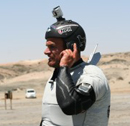
|
|
|
Scuttlebutt News: Rob Douglas - Fastest sailor on the planet
And on October 28th, with the wind blowing up to 45 knots, American kitesailor Rob Douglas (USA) raised the bar further than anyone had gone before, hitting a new record speed of 55.65 knots. While this record remains unofficial until it is ratified by the World Sailing Speed Record Council, a verification process expected to be completed by November or early December, it is safe to call Rob the fastest sailor on the planet. Here Rob shares some of the details: Yes, the changes to the course this year at the 2nd lagoon in Luderitz Namibia were to make it straighter and smoother. Our speed is averaged over a 500 meter distance, so the organizers dug a trench 750 meter long by 3 to 5 meters wide by 1 to 3 feet deep at the event site further to the east in 2010. As speed increases the risk of injury increases. The smoother water in the trench is safer because riders crash less but running in a narrow trench with dry sand downwind creates a bigger problem when riders crash at speeds in excess of 65 MPH. I wore a helmet and a motocross chest and back protector this year for protection. (Note: On Robís next run after he set the record, he got fouled up during the finish and fractured his right wrist.) We have learned a lot over the past three years in Luderitz. Each year there has been a 30 minute window of perfect world record conditions before the tide or wind changes. Five weeks in Luderitz for 30 minutes, so you have to be on the water and ready at all times when the course is open. Smaller boards are not always faster. Nine meter Cabrinha Switchblades kites are the fastest. And if youíre not having fun then you wonít go fast!
Future gains in speed sailing will come from improvements in course and kite design - the current boards have plenty of gears left. The first 50 meters of the course this year was a bit up wind compared to the rest of the course (due to space issues in the 2nd lagoon), which held our speeds at the start to below 50 knots - we should have been hitting the line at 55 knots. Most kites are still not specifically designed for speed. More work on kites will create more efficient shapes that will reduce the amount of drag and required wind, which will improve surface conditions. The fastest kites today are 8 and 9 meters in size. The fastest sailors weigh between 180 and 215 pounds. The equipment is still fairly spread out.....board flex and rocker still differs greatly between riders. Silly....then somebody has to change the definition of sailing. Windsurfers have been breaking records in a trench since 2004. Kitesailors fulfill all requirements to qualify for speed records. We have sails, we are on water greater than 18 centimeters, and we are powered by the wind. No, I do not believe there should be changes to how speeds are categorized. Itís called an outright world record. Big boats will come back in a few years, the human body of a kitesurfer can only tolerate so much load, carbon fiber masts and rigging of the big boats in the future will ultimately set the pace! There are some very windy conditions in the south of France that could compete with Luderitz soon. This could be seen next year. Future records for kites will come from trenches or canals. I believe the fastest 500 meter tracks in the USA currently are in Cape Pogue Bay and at State Beach on Martha's Vineyard where Iíve hit 48 knot averages over the 500 meter course and 59 knots max speeds. The Great Lakes has some serious natural potential too. When Iím not kiting I am usually designing the next generation of boards with my builder Mike Zajicek (Mike's Lab), hanging out with my brothers, surfing or working on my house. My brother and I were not allowed to have toy guns when we were young, so my dad's brother, uncle David, would give them to us for Christmas presents That same uncle David also dropped off a windsurfer one design at the house a few years later. My father likes 'em old and slow and his kids like 'em new and fast, but we are all sailors and enjoy sailing in all its different forms. back to top |







|



